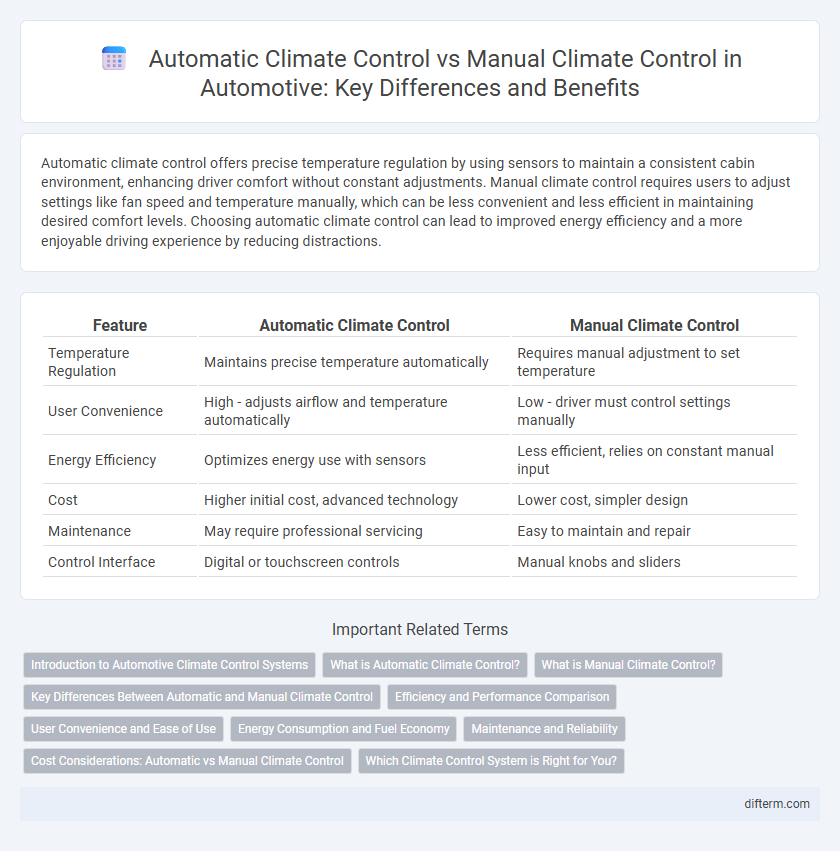Automatic climate control offers precise temperature regulation by using sensors to maintain a consistent cabin environment, enhancing driver comfort without constant adjustments. Manual climate control requires users to adjust settings like fan speed and temperature manually, which can be less convenient and less efficient in maintaining desired comfort levels. Choosing automatic climate control can lead to improved energy efficiency and a more enjoyable driving experience by reducing distractions.
Table of Comparison
| Feature | Automatic Climate Control | Manual Climate Control |
|---|---|---|
| Temperature Regulation | Maintains precise temperature automatically | Requires manual adjustment to set temperature |
| User Convenience | High - adjusts airflow and temperature automatically | Low - driver must control settings manually |
| Energy Efficiency | Optimizes energy use with sensors | Less efficient, relies on constant manual input |
| Cost | Higher initial cost, advanced technology | Lower cost, simpler design |
| Maintenance | May require professional servicing | Easy to maintain and repair |
| Control Interface | Digital or touchscreen controls | Manual knobs and sliders |
Introduction to Automotive Climate Control Systems
Automatic climate control systems in vehicles use sensors and microprocessors to maintain a set cabin temperature by adjusting airflow, fan speed, and temperature automatically. Manual climate control requires the driver to adjust these settings manually, often resulting in less consistent cabin comfort. The integration of automatic systems enhances driving convenience and energy efficiency while reducing driver distraction.
What is Automatic Climate Control?
Automatic climate control is an advanced automotive system that maintains a set cabin temperature by automatically adjusting the air conditioning, heating, and fan speed. It uses sensors to monitor interior and exterior temperatures, optimizing comfort without manual input from the driver. This technology improves fuel efficiency by regulating climate functions precisely and reduces driver distraction compared to manual climate control systems.
What is Manual Climate Control?
Manual climate control in automotive systems allows drivers to adjust temperature, fan speed, and airflow direction using physical knobs or sliders. This system operates independently from external temperature sensors, requiring constant manual adjustments to maintain comfort. It provides basic functionality without the precision or convenience of automatic climate control features.
Key Differences Between Automatic and Manual Climate Control
Automatic climate control systems maintain a set temperature by using sensors and microprocessors to adjust the airflow and temperature automatically, providing consistent cabin comfort. Manual climate control requires the driver to manually adjust knobs or sliders to regulate fan speed, temperature, and airflow, offering more direct but less precise control. Key differences include the automatic system's ability to adapt to changing external conditions and maintain preset temperatures without user intervention, contrasting with the manual system's reliance on continuous user adjustments.
Efficiency and Performance Comparison
Automatic climate control systems optimize cabin temperature by continuously adjusting airflow and temperature settings based on real-time sensor data, leading to enhanced fuel efficiency and reduced driver workload. Manual climate control requires constant user input to maintain comfort, potentially causing fluctuations in energy consumption and less precise temperature regulation. Studies show vehicles with automatic systems can achieve up to 10% better HVAC efficiency, resulting in improved overall vehicle performance and reduced environmental impact.
User Convenience and Ease of Use
Automatic climate control offers superior user convenience by maintaining preset temperatures without the need for constant adjustments, enhancing comfort during driving. Manual climate control requires regular user intervention to adjust fan speed, temperature, and airflow, which can be distracting and less efficient. Modern vehicles with automatic climate systems often include intuitive touchscreen interfaces and voice control, further simplifying climate management for drivers.
Energy Consumption and Fuel Economy
Automatic climate control systems in vehicles optimize cabin temperature by adjusting airflow and compressor operation, leading to more efficient energy consumption compared to manual controls. By maintaining optimal settings without constant driver input, automatic systems reduce unnecessary HVAC load, improving overall fuel economy. Manual climate control often results in prolonged compressor activity, increasing energy use and decreasing miles per gallon performance.
Maintenance and Reliability
Automatic climate control systems typically require less frequent adjustments and provide consistent cabin temperature, reducing wear on components compared to manual controls. Maintenance for automatic systems may be more complex due to sensors and electronic controls, but advanced diagnostics can prevent major failures. Manual climate control units have simpler mechanics, often leading to easier and cheaper repairs, though they may experience faster wear from frequent manual adjustments.
Cost Considerations: Automatic vs Manual Climate Control
Automatic climate control systems typically incur higher upfront costs compared to manual climate control due to advanced sensors and electronic components. Manual climate control remains more affordable for budget-conscious buyers by using simpler, mechanical dials without the need for complex automation. Long-term maintenance expenses may also be greater for automatic systems, given their reliance on sophisticated technology prone to costly repairs.
Which Climate Control System is Right for You?
Automatic climate control systems use sensors to maintain a set temperature, offering consistent comfort with minimal driver input, while manual climate control requires adjusting knobs or buttons to manage airflow and temperature. Drivers who prioritize convenience and steady cabin conditions will benefit from automatic systems, whereas those who prefer direct control and potentially lower costs might opt for manual controls. Evaluating your driving habits, climate preferences, and budget will help determine which climate control system best suits your automotive needs.
automatic climate control vs manual climate control Infographic

 difterm.com
difterm.com